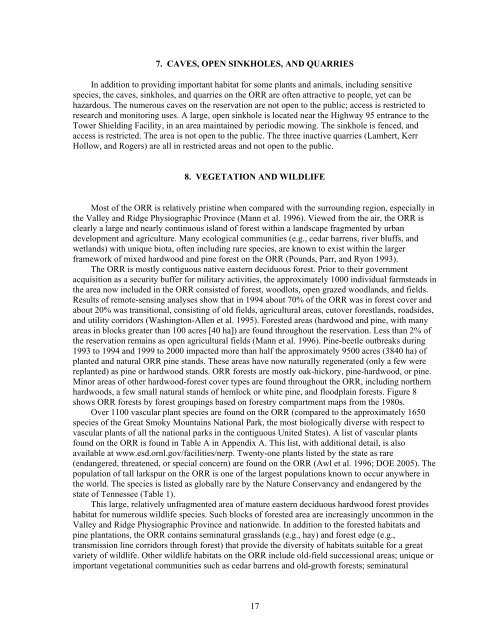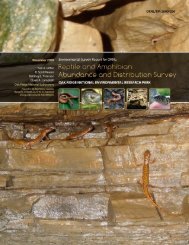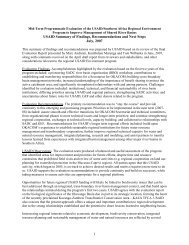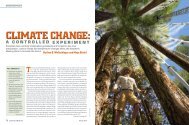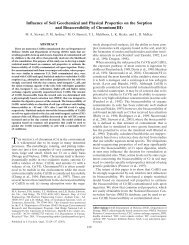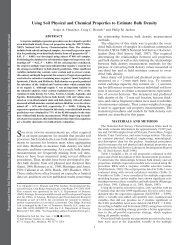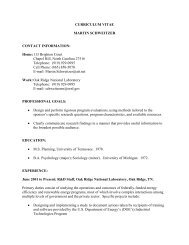oak ridge reservation physical characteristics and natural resources
oak ridge reservation physical characteristics and natural resources
oak ridge reservation physical characteristics and natural resources
Create successful ePaper yourself
Turn your PDF publications into a flip-book with our unique Google optimized e-Paper software.
7. CAVES, OPEN SINKHOLES, AND QUARRIES<br />
In addition to providing important habitat for some plants <strong>and</strong> animals, including sensitive<br />
species, the caves, sinkholes, <strong>and</strong> quarries on the ORR are often attractive to people, yet can be<br />
hazardous. The numerous caves on the <strong>reservation</strong> are not open to the public; access is restricted to<br />
research <strong>and</strong> monitoring uses. A large, open sinkhole is located near the Highway 95 entrance to the<br />
Tower Shielding Facility, in an area maintained by periodic mowing. The sinkhole is fenced, <strong>and</strong><br />
access is restricted. The area is not open to the public. The three inactive quarries (Lambert, Kerr<br />
Hollow, <strong>and</strong> Rogers) are all in restricted areas <strong>and</strong> not open to the public.<br />
8. VEGETATION AND WILDLIFE<br />
Most of the ORR is relatively pristine when compared with the surrounding region, especially in<br />
the Valley <strong>and</strong> Ridge Physiographic Province (Mann et al. 1996). Viewed from the air, the ORR is<br />
clearly a large <strong>and</strong> nearly continuous isl<strong>and</strong> of forest within a l<strong>and</strong>scape fragmented by urban<br />
development <strong>and</strong> agriculture. Many ecological communities (e.g., cedar barrens, river bluffs, <strong>and</strong><br />
wetl<strong>and</strong>s) with unique biota, often including rare species, are known to exist within the larger<br />
framework of mixed hardwood <strong>and</strong> pine forest on the ORR (Pounds, Parr, <strong>and</strong> Ryon 1993).<br />
The ORR is mostly contiguous native eastern deciduous forest. Prior to their government<br />
acquisition as a security buffer for military activities, the approximately 1000 individual farmsteads in<br />
the area now included in the ORR consisted of forest, woodlots, open grazed woodl<strong>and</strong>s, <strong>and</strong> fields.<br />
Results of remote-sensing analyses show that in 1994 about 70% of the ORR was in forest cover <strong>and</strong><br />
about 20% was transitional, consisting of old fields, agricultural areas, cutover forestl<strong>and</strong>s, roadsides,<br />
<strong>and</strong> utility corridors (Washington-Allen et al. 1995). Forested areas (hardwood <strong>and</strong> pine, with many<br />
areas in blocks greater than 100 acres [40 ha]) are found throughout the <strong>reservation</strong>. Less than 2% of<br />
the <strong>reservation</strong> remains as open agricultural fields (Mann et al. 1996). Pine-beetle outbreaks during<br />
1993 to 1994 <strong>and</strong> 1999 to 2000 impacted more than half the approximately 9500 acres (3840 ha) of<br />
planted <strong>and</strong> <strong>natural</strong> ORR pine st<strong>and</strong>s. These areas have now <strong>natural</strong>ly regenerated (only a few were<br />
replanted) as pine or hardwood st<strong>and</strong>s. ORR forests are mostly <strong>oak</strong>-hickory, pine-hardwood, or pine.<br />
Minor areas of other hardwood-forest cover types are found throughout the ORR, including northern<br />
hardwoods, a few small <strong>natural</strong> st<strong>and</strong>s of hemlock or white pine, <strong>and</strong> floodplain forests. Figure 8<br />
shows ORR forests by forest groupings based on forestry compartment maps from the 1980s.<br />
Over 1100 vascular plant species are found on the ORR (compared to the approximately 1650<br />
species of the Great Smoky Mountains National Park, the most biologically diverse with respect to<br />
vascular plants of all the national parks in the contiguous United States). A list of vascular plants<br />
found on the ORR is found in Table A in Appendix A. This list, with additional detail, is also<br />
available at www.esd.ornl.gov/facilities/nerp. Twenty-one plants listed by the state as rare<br />
(endangered, threatened, or special concern) are found on the ORR (Awl et al. 1996; DOE 2005). The<br />
population of tall larkspur on the ORR is one of the largest populations known to occur anywhere in<br />
the world. The species is listed as globally rare by the Nature Conservancy <strong>and</strong> endangered by the<br />
state of Tennessee (Table 1).<br />
This large, relatively unfragmented area of mature eastern deciduous hardwood forest provides<br />
habitat for numerous wildlife species. Such blocks of forested area are increasingly uncommon in the<br />
Valley <strong>and</strong> Ridge Physiographic Province <strong>and</strong> nationwide. In addition to the forested habitats <strong>and</strong><br />
pine plantations, the ORR contains semi<strong>natural</strong> grassl<strong>and</strong>s (e.g., hay) <strong>and</strong> forest edge (e.g.,<br />
transmission line corridors through forest) that provide the diversity of habitats suitable for a great<br />
variety of wildlife. Other wildlife habitats on the ORR include old-field successional areas; unique or<br />
important vegetational communities such as cedar barrens <strong>and</strong> old-growth forests; semi<strong>natural</strong><br />
17


